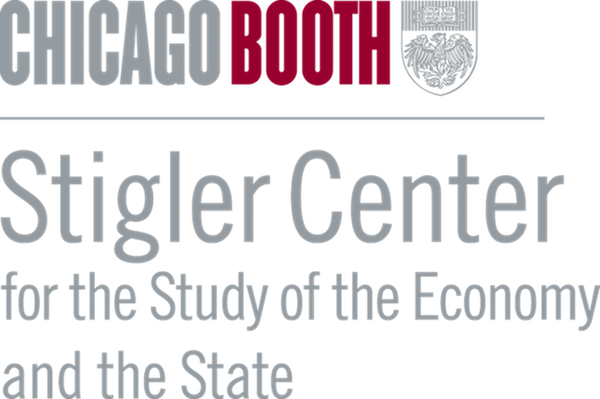Stigler Center Assistant Director Matt Lucky, Ph.D., reviews Joan Williams’ new book, Outclassed, which reflects on the Democratic Party’s loss of what she calls “middle-status” voters. Williams discusses her book with Bethany McLean and Luigi Zingales on this week’s Capitalisn’t episode, which you can listen to here.
In Outclassed, law professor and author Joan Williams aims to explain a heatedly contested modern political mystery: how did the Democratic Party lose its historic connection with average working Americans? Some pundits and scholars point to supercharged disinformation and conspiracy theorizing on social media. Others identify the Democrats’ failure to support sufficiently ambitious left-leaning redistributive programs—“Bernie would have won!”—or to Trump’s appeals to racial resentments and fear. Williams addresses each of these themes, yet she does not find them to be sufficiently convincing explanations.
Instead, Williams’s central argument is that Democrats lost the working class due to a gaping cultural fissure that has separated liberal elites, whom she refers to as the Brahmin Left, from the middle-status Americans: the lower-income tranche of the middle class who have drifted to the right. On this point, Williams is on a solid foundation, as there is a cornucopia of social science research demonstrating that liberal elites and middle-status voters drifting right are distinct in terms of their values, language, and modes of living. That is, Americans’ political allegiances now map onto distinctions in family formation preferences, baby names, where we work, media consumption habits, where we live, stereotypical dress styles and visual symbolism, food and drink preferences, and even preferences for cats versus large dogs! Simply put, political differences in America now systemically map onto distinct modes of living and culture.
In building her case, Williams advances a critical point that class distinctions are not merely a matter of variations in income levels, but of cultural distinctions in terms of values, language, and modes of living. A truck driver and a librarian may earn the same annual income, but not be in the same class; they live different lives, move through different social spheres, etc. Recognizing that class is about culture and modes of living, in addition to economics, suggests that Democrats cannot win back the support of middle-status voters by simply promising ever more generous redistributive policies. Cutting bigger checks from the state will not bridge the cultural divides between liberal elites and middle-status Americans. That said, predistributive policies that preserve a link between the dignity of work and increased wages do offer a more promising avenue to appeal to the middle-status Americans.
The elites within the Democratic Party have failed to properly recognize that they are on the wrong side of a cultural division that separates them from a critical bloc of potentially sympathetic middle-status voters that Democrats need to win elections. According to Williams, the Democrats must advance culturally competent communicators—candidates like John Fetterman in the 2022 Pennsylvania Senate race—who can express the party’s program to middle-status voters using language and values they recognize as their own. To wit, Democrats need to remember how to talk like normal Americans.
In this sense, Outclassed functions as an open letter from one liberal elite to others advocating for evidence-based rhetorical strategies for left-leaning politics in the U.S. Williams builds her case through a series of chapters that emphasize, to an elite liberal audience, how different their lives and values are from middle-status Americans, focusing, for instance, on distinctions around religiosity, attitudes on masculinity, and the meaning of hard work. The purpose of this extended exploration is to drive home to liberal elite readers that they live in a different world than many of the middle-status voters they need to persuade. Here, Williams is echoing a critical insight from political scientists Christopher Achen and Larry Bartels that, “most citizens support a party not because they have carefully calculated that its policy positions are closest to their own, but rather because ‘their kind’ of person belongs to that party” [emphasis added]. For middle-status Americans, liberal elites do not feel like their kind of people because their modes of living have drifted so far apart. Culturally competent messengers who feel like a middle-status kind of person are the necessary and unmet condition for persuading Americans back into a new left-leaning cross-class coalition
That is not to say that most or even many of the MAGA base can be flipped with a bit of polished rhetoric. For the most part, those voters are locked in place in our intensely polarized politics. That said, there is, in Williams’s narrative, a subset of “anti-elites” who voted for Trump who might be persuaded through culturally competent rhetoric. I take those persuadable middle-status voters to be, roughly, individuals who are symbolically conservative but instrumentally liberal. That is, folks who hold left-leaning policy instincts, but who are simultaneously drawn to conservative cultural aesthetics: someone who drives a pickup truck listening to country music and who also supports Medicaid expansion. Again, the point here is that Democrats do not necessarily need to dramatically transform their policy platform, but they do need to articulate those positions in ways that “feel right” to middle-status Americans.
Williams offers the widespread acceptance of gay marriage in the U.S. as a model for how culturally competent persuasion campaigns can convince middle-status voters to embrace a liberal social agenda that expands rights to marginalized groups. In her telling, the success in that instance emerged because,
Gay marriage advocates adeptly tapped [middle-status] moral intuitions in other ways, too. Instead of relying on experts (lawyers) speaking about rights, they tapped authority figures respected in blue-collar circles (a.k.a. validators): clergy, grandparents, older veterans. These spokespeople didn’t make arguments about why their audience should accept homosexuality. Instead, they used a cross-class talk tradition: storytelling. They used “elements of narrativity—the creation of characters, construction of a storytelling ark and the depiction of conflict being resolved” [emphasis added].
That is, gay marriage gained wide acceptance because it was framed rhetorically to appeal to middle-status values around “love, commitment, fairness, and freedom,” rather than invoking the legal application of abstract universal rights as dictated by professor philosopher-man at Stanford. In this instance, liberals do not need to compromise their commitments to expanding rights to historically marginalized populations, but they do need to articulate those commitments in everyday language.
In Outclassed, Williams’s argument stands out among the pack of contending explanations for the electoral woes of the Democratic Party by advancing a compelling and well-evidenced case that captures much of the findings of contemporary political science for an audience who is searching for insights without trudging through regression tables.
With those words of praise registered, I will highlight one point of friction that hinders the potential of Williams’s project that stems, in my reading, from the fact that Outclassed is addressed to that precise audience of liberal elites. Specifically, the book unfolds as largely a narrative involving two main actors: the liberal elites and the middle-status voters whom the former have alienated. This structure makes sense, as the book is addressed to that precise audience of liberal elites and informs them how to communicate with middle-status Americans. Alas, by focusing on those two groups, Williams discounts the role conservative media elites play in constructing mass public opinion.
Throughout Outclassed, middle-status opinions are presented as natural expressions of their inherent values in response to political/social questions. For instance, we are informed that these voters rejected masks during COVID because of their masculine values and embraced President Donald Trump’s 2020 “Stop the Steal” campaign after he lost the election to Joe Biden because of “its ability to help articulate voters’ sense of having been robbed.” There is something useful in understanding conspiracy theories as the product of the mass public attempting to make sense of adversity. However, the propagation of conspiracy theories is often critically dependent not merely on the mass public, but on how in-group elites in politics and media influence those theories.
Indeed, returning to the political science literature, a lot of public opinion in politics is a game of follow the leader, with the public following the direction of the ingroup elites they trust to make sense of the world. Achen and Bartels, in addition to articulating that voters associate with parties that feel like “their people,” also offer that “often enough, [voters] let their party tell them what to think about the issues of the day.” Humans are not born with opinions. They must source them from somewhere in the world. In many cases, that entails that mass public opinion is downstream of in-group elites. For the Stop the Steal example that Williams explores, conservative elites, as Yonchai Benkler et al. contend, aggressively constructed this conspiracy theory in the American public mind. Outclassed largely appears to avoid considering the role conservative elites play in constructing mass public opinion, not simply regarding conspiracy theories, but many of the other dimensions of cultural distinction Williams touches upon, including attitudes on masculinity, the value of work, religiosity, and family values. By taking contingent and constructed mass attitudes as part of the given world, Williams oversimplifies this problem space.That quibble aside, Outclassed is a strong contribution to the efforts currently advanced to make sense of Democrats’ persistent electoral anemia with middle-status voters. Its foundation in political science scholarship concerning the cultural dimension of contemporary partisan polarization and focus on culturally competent communicators as the solution render Williams’s contribution a worthy read for those liberal elites (or anyone curious about American politics!) who want to make sense of contemporary society.
Author Disclosure: The author reports no conflicts of interest. You can read our disclosure policy here.
Articles represent the opinions of their writers, not necessarily those of the University of Chicago, the Booth School of Business, or its faculty.






